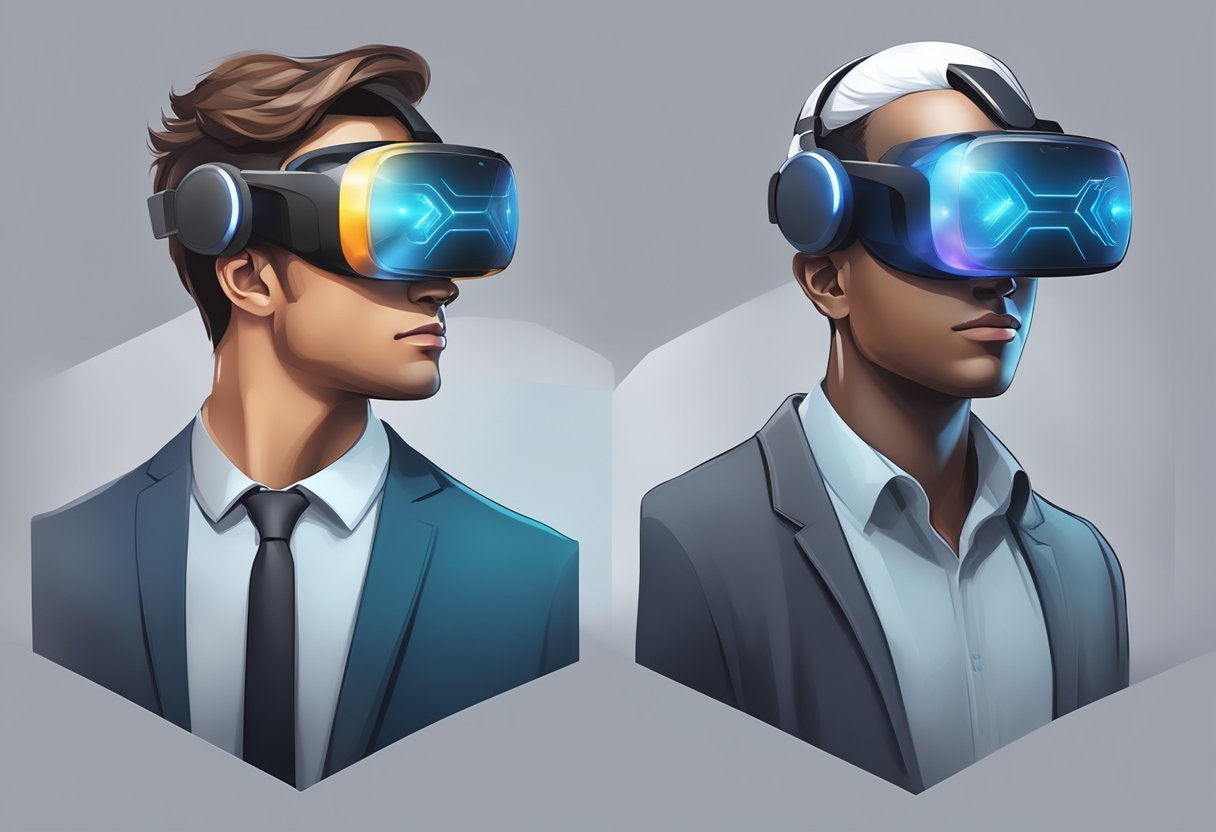The terms “metaverse” and “virtual reality” have become increasingly popular in recent years, with many people using them interchangeably. However, they are not the same thing. The metaverse is a shared virtual space where people can interact with each other and digital objects in real-time, while virtual reality is a computer-generated simulation of a three-dimensional environment that can be experienced through a headset or other devices.
Understanding the differences between the metaverse and virtual reality is important because they have different implications for the future of technology and society. The metaverse has the potential to transform the way people interact with each other and the world around them, while virtual reality can be used for a variety of purposes, from gaming to education and training. By exploring the similarities and differences between the two concepts, we can gain a better understanding of their potential uses and limitations.
Key Takeaways
- The metaverse is a shared virtual space where people can interact with each other and digital objects in real-time, while virtual reality is a computer-generated simulation of a three-dimensional environment that can be experienced through a headset or other devices.
- Understanding the differences between the metaverse and virtual reality is important because they have different implications for the future of technology and society.
- The metaverse has the potential to transform the way people interact with each other and the world around them, while virtual reality can be used for a variety of purposes, from gaming to education and training.
Understanding the Metaverse

The Metaverse is a term used to describe a persistent, shared, and interconnected digital world that is open and accessible to everyone. It is a virtual space where people can interact with each other, create content, and engage in various activities. The concept of the Metaverse has been around for a while, but it has gained more attention in recent years due to the emergence of new technologies such as blockchain, mixed reality, and artificial intelligence.
Components of the Metaverse
Here are five components of the Metaverse:
- Shared Virtual Space: The Metaverse is a shared virtual world where people can interact with each other in real-time. It is a space where people can create, share, and experience content together.
- Embodied Internet: The Metaverse is an embodied internet where people can interact with digital avatars that represent them in the virtual world. It is a space where people can have a digital presence that is connected to their physical life.
- Persistent World: The Metaverse is a persistent world where people can create and modify content that remains in the virtual world even when they are not online. It is a space where people can build communities and develop their online life.
- Open Platform: The Metaverse is an open platform that allows people to create and share content without any restrictions. It is a space where people can innovate and develop new technologies.
- Shared Economy: The Metaverse is a shared economy where people can exchange goods and services using virtual currencies. It is a space where people can participate in various industries and create new opportunities for themselves.
The Metaverse is still in development, and its scope and potential are yet to be fully realized. However, it has the potential to transform the way people interact with each other and the digital world. As such, it is important to consider the implications of the Metaverse for data privacy, security, and connectivity.
Virtual Reality: A Key Component

Virtual Reality (VR) is a technology that has been around for several decades, but it has only recently become accessible to the general public. VR is an immersive experience that simulates a realistic environment, allowing users to interact with it in real-time. The following are five key components of Virtual Reality:
1. Headsets
VR headsets are the primary component of VR technology. They are head-mounted displays that allow the user to see a virtual world. The headset tracks the user’s movement and adjusts the display accordingly, providing a realistic and immersive experience.
2. Immersion
The goal of VR technology is to create an immersive experience that transports the user to a virtual world. The more immersive the experience, the more realistic it feels. This is achieved through the use of high-quality graphics, sound, and haptic feedback.
3. Interaction
Interaction is a crucial component of VR technology. Users must be able to interact with the virtual world in a natural and intuitive way. This is achieved through the use of hand controllers, voice commands, and other input devices.
4. Realistic Environments
VR technology aims to create realistic environments that feel like the real world. This is achieved through the use of high-quality graphics and sound, as well as the use of physics engines that simulate real-world interactions.
5. Software
The software that powers VR technology is critical to its success. The software must be able to create realistic environments, provide smooth and seamless interactions, and be compatible with a wide range of hardware devices.
Overall, Virtual Reality is a key component of the metaverse, but it is not the same thing. While VR provides an immersive experience, the metaverse is a fully-realized virtual world with its own economy, social structures, and rules.
Metaverse vs Virtual Reality: A Comparative Analysis

The Metaverse and Virtual Reality (VR) are two distinct digital realms that have generated considerable excitement and interest in recent years. While both concepts share similarities, they have significant differences that set them apart.
5 Major Differences Between Metaverse and Virtual Reality
Here are the five major differences between Metaverse and Virtual Reality:
- Definition: Virtual Reality is a well-defined technology that has been in use for some time, whereas the Metaverse is still a hypothetical platform that is currently in development.
- Realism: Virtual Reality provides a realistic simulation of a physical environment, while the Metaverse aims to create a more immersive and interactive experience that goes beyond just visual and audio stimulation.
- Social Interaction: Virtual Reality is designed to be a more solitary experience, while the Metaverse is built around social interaction. Users can interact with each other in real-time, creating a more social and collaborative experience.
- Personal Data: Virtual Reality typically collects and stores limited personal data, while the Metaverse is designed to collect and store a vast amount of personal data. This data is used to create a more personalized and immersive experience.
- Purpose: Virtual Reality is primarily used for entertainment, education, and training purposes, while the Metaverse has a broader range of applications, including shopping, working, socializing, and more.
Entertainment
Virtual Reality has been widely adopted for entertainment purposes, such as gaming and movies. It provides a realistic and immersive experience that transports users to different worlds. The Metaverse aims to take this experience to the next level by creating a more interactive and social experience that goes beyond just entertainment.
Education
Virtual Reality has also been used in education and training, providing a safe and controlled environment for students to learn and practice new skills. The Metaverse has the potential to revolutionize education by creating a more immersive and interactive learning experience that allows students to collaborate and learn in real-time.
Shopping
The Metaverse has the potential to change the way we shop by creating a more immersive and interactive experience. Users can browse virtual stores, try on clothes, and interact with products in a more realistic way.
Working
The Metaverse has the potential to change the way we work by creating a more collaborative and immersive experience. Users can work together in real-time, creating a more social and interactive work environment.
Realistic
Virtual Reality provides a realistic simulation of a physical environment, while the Metaverse aims to create a more immersive and interactive experience that goes beyond just visual and audio stimulation. The Metaverse is designed to create a more realistic and immersive experience that engages all the senses.
Social Interaction
The Metaverse is built around social interaction, allowing users to interact with each other in real-time, creating a more social and collaborative experience. Virtual Reality, on the other hand, is designed to be a more solitary experience.
Text
Text is an essential element in the Metaverse, allowing users to communicate with each other in real-time. Virtual Reality, on the other hand, relies more on audio and visual communication.
In conclusion, while both the Metaverse and Virtual Reality have some similarities, they are two distinct digital realms with significant differences. The Metaverse has the potential to revolutionize the way we interact with each other, work, shop, and learn, creating a more immersive and interactive experience. Virtual Reality, on the other hand, is a well-established technology that provides a realistic and immersive experience for entertainment and education purposes.
Future Prospects and Challenges

As the metaverse and virtual reality continue to evolve, they hold great potential for various industries, including entertainment, education, shopping, and working. However, with this potential comes a set of challenges that need to be addressed.
One of the most significant challenges is accessibility. While virtual reality and the metaverse offer immersive experiences, they require expensive hardware and software, limiting access for many individuals. Additionally, digital avatars and virtual spaces need to be designed with inclusivity in mind to ensure everyone can participate fully.
Another challenge is security and data privacy. As users spend more time in the metaverse and virtual reality, they generate large amounts of personal data, which can be vulnerable to hacking and misuse. Developers need to ensure that the appropriate security measures are in place to protect users’ data.
The development of the metaverse and virtual reality also raises questions about the line between online life and physical life. As users spend more time in virtual spaces, they may become disconnected from their physical surroundings, leading to potential negative effects on mental health and social interaction. It is essential to consider the therapeutic and transformative potential of these technologies while also being mindful of their impact on individuals and society as a whole.
Furthermore, the development of the metaverse and virtual reality is still in its early stages, with many technical and practical challenges that need to be addressed. For example, creating digital twins of real-world objects and locations requires significant investment and resources. Additionally, blockchain technology and NFTs offer exciting possibilities for virtual goods and real estate, but their implementation raises questions about ownership and community governance.
In conclusion, the metaverse and virtual reality offer immense potential for innovation and growth across various industries. However, developers and stakeholders need to address key challenges such as accessibility, security, and the impact on individuals and society. By doing so, they can create immersive and interconnected virtual spaces that offer transformative experiences while also being mindful of their impact.
Frequently Asked Questions
What is the difference between the metaverse and virtual reality?
The metaverse is a hypothetical platform that is currently in development, while virtual reality is a technology that is available today. The metaverse is a fully immersive digital world that allows users to interact and create content. In contrast, virtual reality is a simulated experience that can be similar to or completely different from the real world.
How does metaverse technology differ from VR technology?
Metaverse technology is more advanced than VR technology. The metaverse is a fully immersive digital world that allows users to interact and create content. In contrast, VR technology is limited to a simulated experience that can be similar to or completely different from the real world.
What are some examples of virtual reality worlds?
Some examples of virtual reality worlds include Second Life, Minecraft, and World of Warcraft. These virtual worlds allow users to interact with each other and create content.
What is the relationship between AR and the metaverse?
Augmented reality (AR) is a technology that overlays digital content onto the real world. The metaverse is a fully immersive digital world. While there is a relationship between AR and the metaverse, they are not the same thing.
Will the metaverse be exclusively VR or will it include AR as well?
The metaverse will likely include both VR and AR technologies. However, it is still in development, and it is not clear how these technologies will be integrated.
How does the concept of the metaverse relate to extended reality?
The concept of the metaverse is related to extended reality (XR). XR is an umbrella term that includes VR, AR, and mixed reality (MR). The metaverse is a fully immersive digital world that could be considered a form of XR.
Is virtual reality same as metaverse?
No, virtual reality is not the same as the metaverse. Virtual reality is a simulated experience that can be similar to or completely different from the real world. The metaverse is a fully immersive digital world that allows users to interact and create content.
Why is virtual reality called metaverse?
Virtual reality is not called metaverse. The metaverse is a hypothetical platform that is currently in development.
Can metaverse replace reality?
No, the metaverse cannot replace reality. While the metaverse is a fully immersive digital world, it is not a substitute for the real world.
What is not possible in metaverse?
It is not possible to replicate all aspects of the real world in the metaverse. For example, physical sensations such as touch and smell cannot be replicated.
Metaverse vs virtual reality pros and cons
The metaverse has the potential to revolutionize the way we interact with digital content. It allows for fully immersive experiences and the ability to create content. However, it is still in development and has not yet been fully realized.
Virtual reality, on the other hand, is a technology that is available today. It allows for immersive experiences, but it is limited by the technology available.
Metaverse vs virtual reality cost
The cost of the metaverse is not yet known, as it is still in development. The cost of virtual reality technology varies depending on the device and software used.




